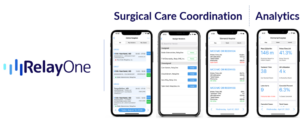According to the recently-released HIMSS 2022 State of Healthcare Report, the pandemic greatly accelerated healthcare’s digital transformation.
The report also reflects the substantial changes that new technologies are bringing to providers and patients.
Of those surveyed for the report, 99% of U.S.-based health system leaders agreed that it was important for their organizations to actively invest in digital transformation, so it’s clear that digital health transformation remains a top-level priority for health systems. While 84% said that their organizations required them to use digital health solutions, 79% chose to use them on their own initiative.
More than half of respondents reported having used at least one digital healthcare solution, and most were highly satisfied with those solutions.
Organizations looking for low-risk, high value opportunities for digital transformation can look no further than RelayOne’s no-PHI mobile surgical care coordination solution. Cone Health achieved significant results implementing RelayOne’s solution.
Case Study: How Cone Health Cleared its COVID-19 Case Backlog with the Help of RelayOne’s Surgical Care Collaboration Solution
Typically, managing Cone Health’s 73 operating and procedural rooms and some 4,000 cases each month is no easy task. But when the global pandemic brought elective surgeries to a halt for months on end, the health system’s schedule and revenue was thrown off track.
Due to the COVID-19 surge, and out of an abundance of caution, Cone Health paused elective surgeries in March 2020. The effects, including staff reprioritization, rippled through the system. Operating rooms reopened in June, but by then, trouble loomed.
Not only was there a backlog of more than two months of scheduled procedures or approximately 6,000 cases, but also surgeons were unable to operate and continued to see patients in the office. That meant identifying more surgery needs that would have to be met as soon as possible.
Like many health systems, Cone Health was facing a revenue shortfall totaling millions of dollars. Fortunately, administrators were planning for the inevitable surge in backlogged procedures that would rapidly right their financial ship—if they could increase throughput to levels not seen before.
Reviewing the data, Cone Health administrators initially projected that it would take until at least January to clear the operating room backlog in most places. In some areas, estimates went out a year or more.
Determined to accelerate their recovery, Cone Health looked to RelayOne’s surgical care collaboration solution that they had implemented before COVID-19 struck to improve coordination with surgical staff and vendors.
Health system leaders hoped the real-time scheduling updates and staff time savings would drive the efficiencies required to manage more cases in less time.
The results were impressive. “We were caught up by the middle or end of September,” said Wayne McFatter, RN, MSN, CNOR, RFNA, Co-Director of Perioperative Services for Cone Health. The surgical centers made up all revenues lost to the spring’s COVID-19 shutdowns and drove the entire hospital system back to financial stability.
Where would Cone Health stand today without RelayOne? “We would still be catching up,” said Sharon McCarter, RN, BSN, Wayne’s counterpart in Perioperative Services.
How can one easy-to-implement mobile solution make such a difference in surgery throughput and predictability? The answer: RelayOne helps Cone Health stay on top of the often-rapid changes in case scheduling.
To learn more and to read the full Cone Health case study, click here.
